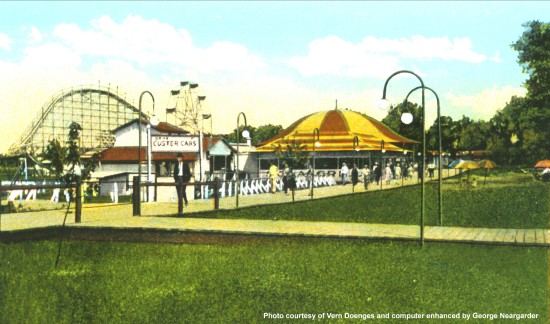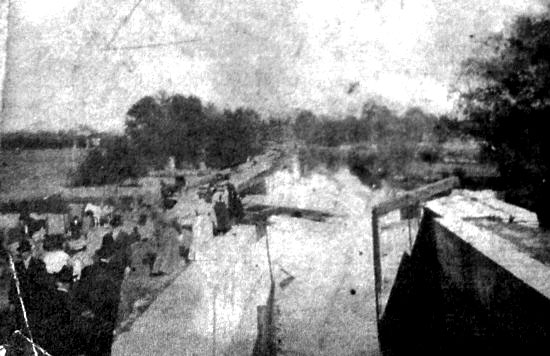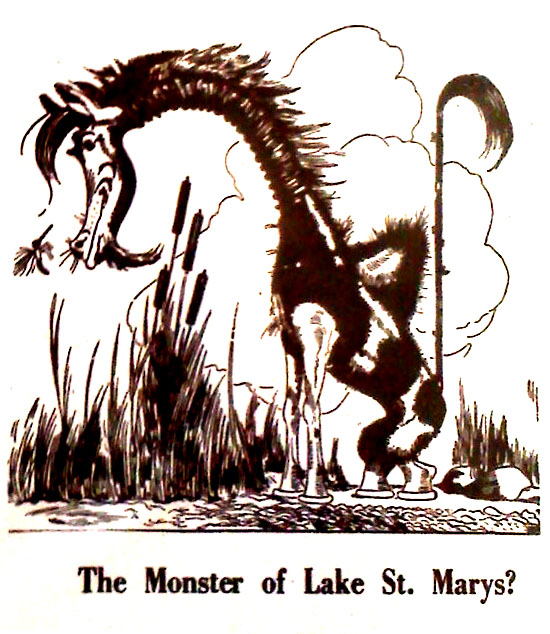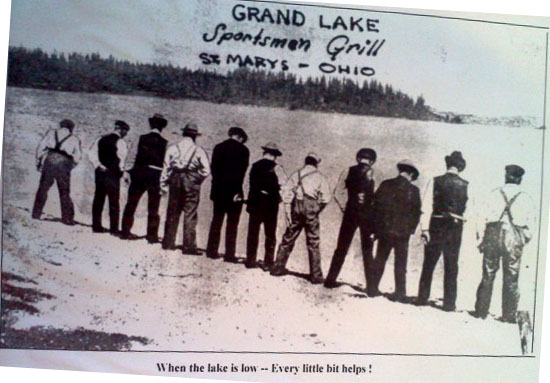What you already know
Grand Lake St. Marys has served as a recreational and economic hub, as well as a natural wildlife habitat, for more than 160 years. Ohio’s Other Great Lake has a storied history that is not only fascinating to the hundreds of thousands it directly serves, but also of great significance to the history of the United States and the entire the world. You might know, for example, that:
- Grand Lake St. Marys was once the world’s largest artificial body of water (it was dug by 1,700 German and Irish immigrants from 1837 to 1845)
- It was created to supply the Miami and Erie Canal, a vital supply source connecting the Ohio River in Cincinnati and Lake Erie in Toledo
- Grand Lake St. Marys was home to the world’s first off-shore oil well, with waterbound derricks positioned on the lake to pump oil from beneath its water
- Gordon State Park once sat on the banks of GLSM, an amusement park complete with a boardwalk and a wooden rollercoaster that attracted national acts and visitors from all over the United States
And these aren’t the only stories to come from Grand Lake St. Marys. Indeed, hundreds of thousands of people have their own Grand Lake St. Marys stories, a few of whom have recorded some of the lake’s historical highlights – and lowlights – for us to enjoy today. Much of the lakes’s past has undoubtedly been lost to time, but there remain a few stories grand enough to retell here. How many of them do you know?
The birth of Grand Lake St. Marys

Grand Lake St. Marys – East Bank Circa 1890s
Grand Lake St. Marys East Bank/Circa 1890s. Photo from George Neargarder’s collection
- How big was Grand Lake St. Marys? Grand Lake St. Marys was dug from 1837 to 1845 and originally held 17,000 acres of water. It held over 12 billion cubic feet of water, was approximately nine miles long by three miles wide, and had over 52 miles of shoreline
- Hard work, little pay. Irish and German settlers hand-dug the lake from a swampy prairie. The pay? Thirty cents and a jigger of whiskey a day. The whiskey was to fend off malaria and to “increase morale”
- The middle of the canal. Grand Lake St. Marys supplied the Miami and Eric Canal with north-flowing water (Loramie Summit, near New Bremen, is the highest point along the canal. All water north of Loramie summit flows north, and all water south accordingly flows south)
- Cheap shipping. The construction of the canal and its reservoirs significantly lowered freight charges. For example, the cost to ship a bushel of wheat 100 miles dropped from one dollar to fifteen cents
- What did it cost to dig the lake? Total cost to dig the lake? About $600,000. In today’s money? Over $12 million. And estimating current costs to clear trees and soil at approximately $30,000/acre, if the project were undertaken today it would cost well over half a billion dollars
- The lake was almost filled in! The railroad revolution of the late 1800s, along with the Great Flood of 1913, spelled the end of the Miami and Erie Canal. And Grand Lake St. Marys almost went with it. Many people, including Ohio’s attorney general, felt the lake would be more valuable as corn fields and should be filled in. However, a local faction convinced legislature to retain the lake, citing the benefits of moisture to combat draughts, increase health, and provide water for nearby farmland. Profit potential was also mentioned
- No more commercial fishing. Commercial fishing was once a major enterprise on Grand Lake St. Marys – at least until 1884, when limits were placed on the number of fish one could remove from state waters
- First tourists. Up until 1890, 75% of the lake’s shoreline was timberland and was dotted with sportsmen’s lodges and professional guides who would take tourists hunting, fishing, and sightseeing on the world’s largest artifical lake. The railroads might have ended the canal, but they also brought an economic boon to Grand Lake St. Marys as the preferred method of travel for these money-spending sportsmen
- A slice of Vegas. Many visitors of the late 1800s -early 1900s period would take shuttle boats to GLSM’s islands to enjoy a picnic and other recreation. One island was even reported to be a resort complete with “gambling, liquor, and rouge-cheeked girls.”
- Less work, more play. In 1915 the state of Ohio determined that with the canal no longer in use, Grand Lake St. Marys would be repurposed as a public recreation and pleasure resort area. It has since served in this capacity – as a recreational hub – for the vast majority of its existence
Click here to visit our Grand Lake St. Marys History Photo Gallery!
Click here for the full history of Grand Lake St. Marys!
The oil under Grand Lake St. Marys

Oil Wells – Grand Lake St. Marys
- World leader in oil. From the mid-1880s to the 1910s, northwest Ohio was the leading oil-producing region in the world and home to the world’s first offshore oil wells
- Derrick lights lit the sky. More than 150 oil and natural gas wells were drilled in and around Grand Lake St. Marys
- A potential multi-billion-dollar industry? Individual wells in Grand Lake St. Marys output between 25 and 250 barrels of oil daily, and the lake’s peak annual production in 1896 totaled 23 million barrels – worth more than $2 billion today! Some speculate that oil and natural gas could still be mined from Grand Lake St. Marys
Want to see more photos? Click Here.
Click here for more history and a map of the oil derricks in and around Grand Lake St. Marys!
Gordon State Park

Gordon State Park Custer Cars and boardwalk. Photo from George Neargarder’s collection
- A major attraction on the banks of Grand Lake St. Marys. Gordon State Park was built on 13 acres in what is now Villa Nova and operated from 1924 to 1933, attracting hundreds of thousands of visitors from all over the country in its nine years. The amusement park attracted 45,000 visitors over Fourth of July weekend in 1926
- It was like Cedar Point, only smaller. Gordon State Park featured everything you would expect from an amusement park: miniature railroad, pony tracks, crazy house, custer cars, the Old Mill Coaster, a merry-go-round, a 60-foot ferris wheel, and Devil’s Backbone, a 90-foot high 2,500-foot long wooden rollercoaster that was the second largest in Ohio at the time. Other attractions included the Mary Jane, a boat tour of Grand Lake St. Marys; speed boat rides, and concessions that were mostly locally-owned and therefore helped bolster the local economy
- Dance, dance dance! The highlight of Gordon State Park was the dance pavilion, a 300 by 50 foot facility known alternately as “The Pier” and “The Palace.” It could accommodate hundreds of people and routinely brought in large acts from all over the region and country
- A terrible trifecta. Sadly, Gordon State Park suffered two fires that burned down the dance hall and Devil’s Backbone. No cause was ever found for the first, and the second fire burned down a smaller, second dance hall built after the first burned down. Add to the fires a devastating tornado and the Great Depression, and Gordon State Park ceased to exist in 1933. Stil, the once-thriving amusement park demonstrates what could be done with a little land, a great attraction, and some savvy marketing.
Click here to see more photos!
Click here for the full history of Gordon State Park!
Terrorist attack!

A photograph of the East Bank Bulkhead near St. Marys depicting the gates after a dynamite explosion threatened to drain Grand Lake St. Marys. Notice the tattered wooden gates in the center and the onlookers on the left. Photo from George Neargarder’s collection
- Explosion! On August 22, 1904, an attempt was made to drain Grand Lake St. Marys by dynamiting the gates of the East Bank Bulkhead near St. Marys. The explosion tattered the gates, but not enough to release over 17,000 acres of water
- St. Marys nearly wiped from the map! As you’ll recall, many were proponents of returning the lake to farmland. Newspaper accounts at the time surmised that the dynamiters were trying to do just that after the state passed legislation to reinforce the banks and retain Grand Lake St. Marys.
- Interestingly, it was believed that the plotters had targeted the bulkhead so that the water would flow down the feeder channel, into the canal, and ultimately into the St. Marys River – sparing St. Marys from devastating flooding. Had they tunneled into the East Bank and sparked the dynamite there, it was stated that St. Marys would have been wiped from the map. Had they placed the dynamite down between the gate posts, the plan might have succeeded. Instead they placed the dynamite on top of the stone walls.
- Blast felt nine miles away. Shockwaves from the blast traveled nine miles through the water and rattled Celina, but was not felt one mile away in St. Marys. On the east side of the lake, only the closest to the blast felt and heard it – and it even wrecked a two-story house located just 50 yards away. Incredibly, the family within survived.
- State investigation failed. Despite the state’s vow to hunt down and capture the perpetrators, no one was ever indicted for the crime.
Click here to read the rest of the story!
A lake divided

A response from Celina’s Daily Standard to St. Marys’ The Evening Leader during the war over the proper name of Grand Lake St. Marys. Photo from George Neargarder’s collection
- What’s in a name? For decades the local lake community has battled over the official name of Grand Lake St. Marys – so much so that The Evening Leader even once threatened to sue The Daily Standard over the matter!
- A war of words. The lake has been called Lake Mercer, Lake St. Marys, Mercer Reservoir, Grand Reservoir, Grand Lake, Lake Celina, and, of course, Grand Lake St. Marys.
- The original name? The lake was originally called Lake Mercer, or the Mercer Reservoir. At that time Auglaize County (on the east side of the lake today) did not exist. St. Marys was in Mercer County, and served as the County Seat. In 1848, Auglaize County was carved out of Mercer and Allen counties.
- And the winner is… The argument was so famous that Ohio Magazine even ran a feature about it, titled “A Lake Divided.” After decades of debate, the moniker Grand Lake St. Marys was officially recognized by the U.S. Geographic Survey and the State of Ohio.
Visit our Grand Lake St. Marys History Photo Gallery!
The Hoedag

Newspaper excerpt of the Hoedag. Photo from George Neargarder’s collection
- Lake monster! The Hoedag, a monster that reportedly lives in Grand Lake St. Marys, was first “reported” in 1912
- What does it look like? The beast was said to be the target of many fruitless hunting expeditions, and is 3/4 the size of an elephant, posseses a serpentine body with a back hump, chicken-like feet, a green eye on the forehead and a red eye on the long tail, and is covered with hair and feathers.
- What does it eat? The Hoedag’s diet supposedly consists of the farm dogs that once ventured into her native cattail habitat, frightened humans (she has been linked to several human disappearances), and her favorite food, pumpkin pie
- What does it sound like? The Terrible Hoedag makes a moaning sound, like a mix between the call of a yahoo bird and the whinee of a horse; and has also been heard cackling and screaming when amused. It is believed that the Hoedag is lonely and starved for affection
Learn more about the Hoedag in our photo gallery!
More amazing lake facts!

Photo from George Neargarder’s collection
- Wild Bill and Annie Oakley, too. The Celina Chautauqua resort, located near present-day Mercelina Park, was once trumpeted as the “finest pleasure resort in Ohio.” The resort featured many entertainers, drama, theologians, impersonators, humorists, and choral groups – and was once visited by Wild Bill’s Wild West Show, including Annie Oakley
- Locals V. The State. When the lake was being dug, many on the north and south sides who had given up their land for it claimed they had not been compensated by the state. What’s more, residents on the west side complained that overflowed water, which stood at a few inches deep, would bring disease.
- In 1843 a small group petitioned the state to compensate landowners and to drain the extra water. They were told by the Board of Public Works in Piqua, Ohio, to “Help yourselves if you can.” When the group then threatened to cut into the west bank and drain the water themselves, they were told that the Piqua guard would “be with you and rout you on that day.”
- Four days later, the group made a cut into the west bank to drain the water. The act resulted in 34 arrests, including those of the county officers, sheriff, judges, clerks, auditor, treasurer, recorder, surveyor, farmers, merchants, and private citizens.
- Despite the fact that the damage cost the state more than $17,000 to repair, the Grand Jury refused to indict those arrested and the matter was settled.
- Bridging the lake. There was once a proposal to build two bridges, or causeways, across GLSM from the north to the south side. See the proposed bridges on a map
Grand Lake St. Marys, Now and in the Future
What is Grand Lake St. Marys today? Where will it be tomorrow? Though the reservoir was initially intended to be a northbound water supply for the Miami and Erie Canal, it only served in that capacity for 15 of its more than 160-year existence. The majority of the time – and officially since 1915 – Grand Lake St. Marys has been designated as public property set aside for pleasure and recreation
The lake has also served as a natural wildlife habitat, and is on the major migration routes of several migratory birds and even Monarch butterflies. The waters are home to crappie, bass, bluegill, walley, catfish and perch.
Grand Lake St. Marys is for flora and fauna, tourists and business, boaters and hunters/fishers, and lovers, friends, and family. But Ohio’s Great Lake is also threatened, and the safety, welfare, and economic stability of the lake community are jeopardized. Today we have touched on the rich and fascinating history of Grand Lake St. Marys. Over the following weeks we will take a close look at the factors that threaten to destroy the lake and what needs to be done to prevent it.
The future of Grand Lake St. Marys depends on you.
Yesterday, Grand Lake St. Marys was indeed the grandest of them all. Today it is in trouble. What tomorrow brings is unknown.
We can do nothing and allow the lake to meet its end. Or, we can work together to return Grand Lake St. Marys to its former glory and power as a famous recreation hub and thriving economic boon. You can start by downloading your Personal Action Plan.
** The Lake Improvement Association extends a grateful thank you to
George Neargarder, who lent his valuable time, expertise, and materials
for the History of Grand Lake St. Marys. **
